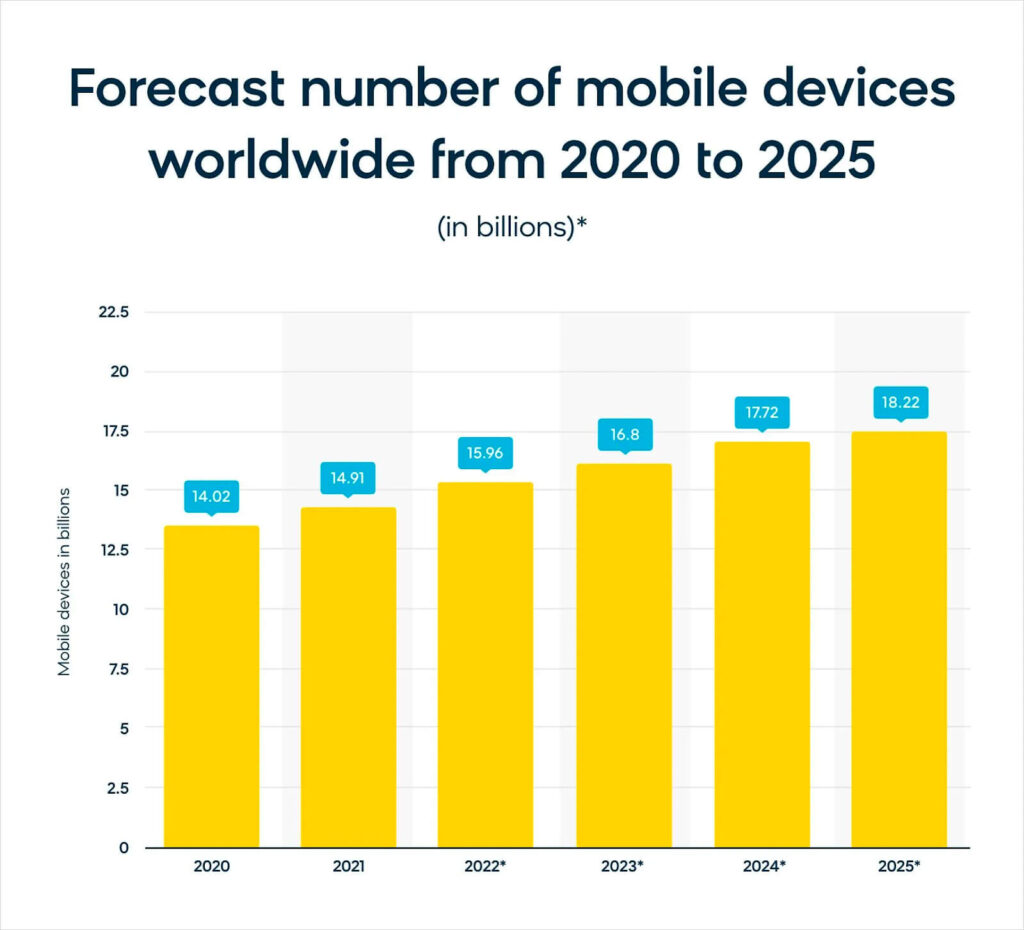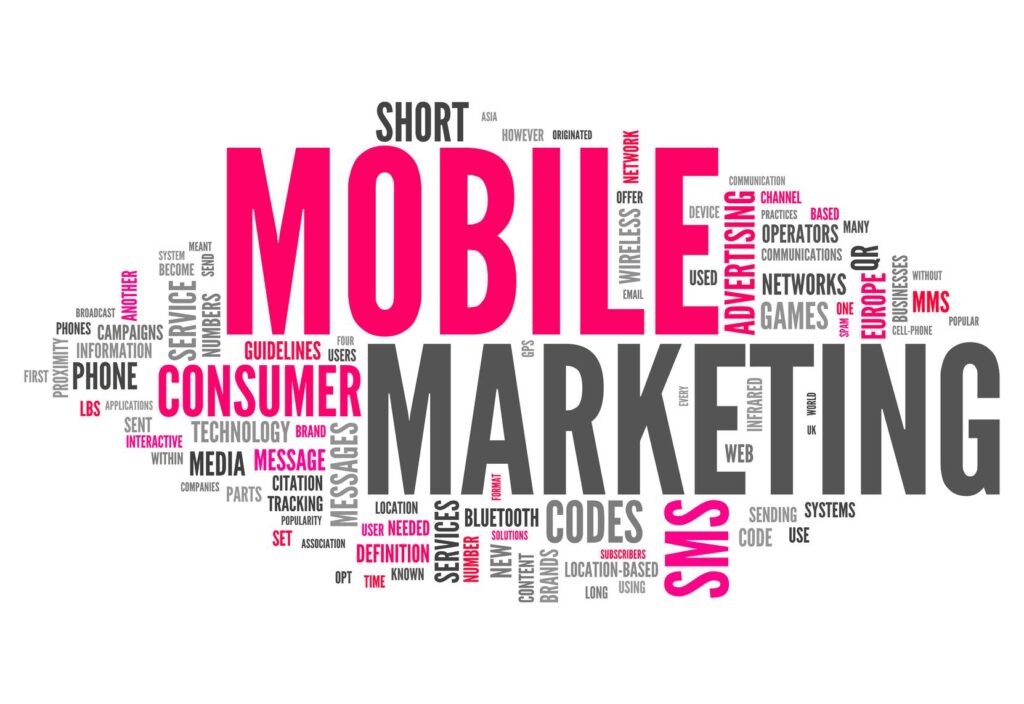Are you utilizing mobile marketing to attract customers to your store? If not, you should consider it.
The way people shop has changed because of the global pandemic. To grab customers’ attention and bring them to your store, it’s crucial to be where they are – and that’s increasingly on mobile devices.
Mobile usage for shopping has surged, with an 86% increase in time spent on shopping apps in 2023 compared to the previous year. Brands are putting more emphasis on their mobile strategies to engage customers.
In this detailed guide, you’ll explore the world of mobile marketing. You’ll learn what mobile marketing entails and uncover various tools and strategies you can leverage to drive foot traffic to your store.
What is Mobile Marketing?
Mobile marketing means advertising to people using smartphones and tablets. Usually, mobile ads use features like push notifications and location tracking to show ads that are more timely and fitting.
The numbers tell us that lots of people use mobile devices for online stuff. There are over 6 billion mobile phone users worldwide, and this number is expected to grow by “several hundred million” in the future.
Moreover, mobile phones, especially smartphones, are super important for shopping now. Gartner says that smartphone sales kept rising in 2021. Also, studies reveal that 79% of smartphone users bought something online in 2022.
But it’s not just about buying stuff. People use mobiles to check things out before they buy. In retail, mobile sales are predicted to hit 10.4% by 2025, which is more than double what it was before the pandemic. This means there’s a big chance to reach possible customers with messages that consider time, location, and what they like.
Why Is Mobile Marketing Effective?
Mobile marketing has become hugely popular in recent times because of one straightforward reason: People all around the globe have grown more reliant on their mobile gadgets.

You can see evidence of this everywhere you go. Almost everyone owns a smartphone, everyone is connected, and everyone uses their mobile devices to search, shop, and interact with their favorite brands.
In 2021, there were nearly 15 billion mobile devices in operation worldwide, and this number is expected to rise even more. By 2025, it’s estimated that the number of devices will surpass 18 billion. Considering that mobile phones currently make up more than half of all internet traffic, it’s clear that mobile marketing isn’t just a nice addition to your marketing plan anymore. It’s a crucial part of your business’s future.
Customers prefer to buy things using their mobile phones.
A few years ago, people worried that shoppers wouldn’t want to buy stuff on their phones, but the numbers tell a different story. Mobile e-commerce sales topped $430 billion in 2022 and are expected to hit $710 billion by 2025. That’s 44% of all online sales, all happening on mobile devices.
In just a few years, mobile is set to handle most online purchases. That’s why brands should focus more on mobile marketing in the future.

Types of Mobile Marketing: Mobile Marketing Strategies
When you’re planning your mobile marketing plan, there are several options to think about. Some of the most important types of mobile marketing include SMS marketing, social media marketing, location-based marketing, proximity marketing, and in-app marketing. Let’s see how these mobile advertising strategies work.
1. Text Message Marketing (SMS Marketing)
Text message marketing, also called SMS marketing or text marketing, involves sending promotions, deals, coupons, and other alerts directly to potential customers’ phones via text messages of 160 characters or less.
SMS marketing is effective because text messages have high deliverability and engagement rates. Statistics indicate that:
- SMS open rates typically range from 90-99%.
- Around 90% of SMS messages are opened within 3 minutes.
- Click-through rates can be more than double that of email.
This effectiveness is largely because people usually have their phones with them and receive push notifications for incoming text messages, making them harder to ignore.
Because text messages are brief, many marketers include links for recipients to get more product information or codes that prompt follow-up messages. It’s important to avoid overusing SMS marketing; it’s most effective for time-sensitive promotions.
2. Social Media Marketing
Many people use smartphones to access social media platforms. Statista data reveals that globally, Facebook boasts more than 2.8 billion monthly active users, closely followed by YouTube, WhatsApp, and Instagram. With such a massive user base, it’s logical to incorporate social media into your mobile marketing strategies.
Social media allows you to establish a personal connection with your customers through comments and messages. It’s also a great way to increase brand visibility and enhance conversions through customer referrals and recommendations.
While some businesses rely on organic social media posts, many now turn to social media advertising to ensure they reach the right audience. Some options include:
- Facebook ads or boosted (promoted) posts
- Promoted tweets on Twitter
- Shoppable or promoted pins on Pinterest
- LinkedIn ads or promoted posts
With this mobile marketing approach, you can define your target audience using demographic data and set campaign objectives, budgets, and durations.
3. GPS-Based Marketing
GPS-based marketing utilizes the GPS feature on smartphones to help advertisers display promotions and relevant content based on users’ locations. Sometimes referred to as geotargeting or geolocation marketing, this approach tailors marketing efforts to where users are physically located.
Studies indicate that the global location-based advertising market, valued at over USD 62 billion in 2019, is projected to grow by over 17% from 2022 to 2027. This type of marketing tends to drive more engagement and elicit better responses because it is directly relevant to mobile users’ locations and activities.
For instance, you can present a promotion for a nearby restaurant to someone who is in the vicinity, encouraging them to visit. Companies like Coach have successfully utilized location targeting to attract thousands of visits to their stores, demonstrating the effectiveness of this method in increasing foot traffic.
4. Proximity Marketing
Bluetooth-based marketing, also known as proximity marketing, is another aspect of location-based marketing. It allows you to utilize Bluetooth technology to determine the location of potential customers and target them with relevant promotions.
One example of this is beacon marketing, which relies on physical Bluetooth-enabled devices placed in or near stores. These devices emit short-range signals to nearby mobile devices, which users see when they are close to your location. This method has been proven effective in driving foot traffic. Toyota, for instance, utilized proximity marketing to attract more customers likely to make purchases at local car dealerships.
5. App-Based Marketing
Smart marketers recognize the importance of the app market. According to Business of Apps, the top five apps include TikTok, Instagram, Facebook, WhatsApp, and Telegram. However, there are hundreds of thousands of other apps available, which is why in-app advertising has become a crucial mobile marketing strategy.
Various types of in-app advertising include:
- Display advertising – such as banners appearing at the top or bottom of a mobile screen.
- Native advertising – designed to blend in with the app environment.
- Video ads.
- Interstitial ads – which pop up between app actions. For example, they might appear when transitioning from one game level to another.
6. Understanding Your Audience
In mobile marketing, it’s crucial to focus on understanding how consumers behave rather than just their demographics. To thrive, you need to have a deep understanding of your audience. What interests them? What puts them off? How do they prefer to consume content online? What will convince them to take action, and what will make them stay loyal customers? Your mobile marketing strategy’s success hinges on comprehending all these factors.
In the last decade, mobile search volume has increased at an annual rate of over 200%.

7. Mobile-Friendly Design
As mentioned earlier, mobile shopping is growing quickly. If you’re launching a marketing campaign, it’s crucial to ensure your website follows mobile-friendly design principles. Everything from menus to internal pages to images should be optimized for use on mobile devices.
8. Mobile-optimized ads and Landing Pages
When people click on ads, they usually expect to see something interesting and easy to understand. That’s why it’s important to make sure your landing pages and ads work well on mobile devices. Follow good practices for creating landing pages to ensure they are effective on mobile. If your ads don’t display properly on mobile, fewer people might click on them.
9. Set up Key Performance Indicators
Key performance indicators (KPIs) are metrics used to assess the effectiveness of your advertising efforts. Your mobile marketing campaigns’ success relies on your ability to pinpoint the most relevant KPIs. Engagement, acquisition, customer experience, and conversions are examples of key performance indicators that can help gauge your mobile marketing efforts.
10. Monitor Your Progress
To enhance your mobile marketing efforts, it’s essential to experiment with new approaches and closely monitor the outcomes. Stay informed about the status of your various advertising endeavours and regularly assess which ones are yielding the best results. By doing so, you can avoid wasting resources on ineffective strategies and instead concentrate on enhancing those that are performing well.
Final Words
In summary, mobile marketing isn’t merely a trend; it reflects a fundamental shift in consumer behaviour. As people increasingly rely on smartphones and tablets for shopping, communication, and entertainment, businesses must capitalize on mobile marketing to engage effectively with their audience. From SMS and social media ads to GPS-based and app-centric strategies, a range of tactics exist to connect with consumers on mobile platforms. Understanding audience preferences is vital for crafting compelling campaigns that drive engagement and conversions.
Optimizing websites, ads, and landing pages for mobile ensures a seamless user experience, boosting customer satisfaction and retention. Monitoring key performance indicators helps refine strategies for optimal results.
Integrating mobile marketing into overall strategies isn’t just beneficial; it’s necessary for competitiveness. By embracing mobile marketing, businesses can reach their target audience, drive foot traffic, and achieve sustainable growth in the digital era.

